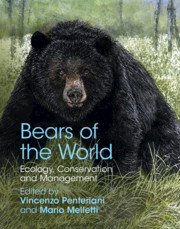53 results
Plate Section (PDF Only)
-
- Book:
- Bears of the World
- Published online:
- 16 November 2020
- Print publication:
- 26 November 2020, pp 391-414
-
- Chapter
- Export citation
Chapter 19 - Bears in Human-Modified Landscapes: The Case Studies of the Cantabrian, Apennine, and Pindos Mountains
- from Part III - Human–Bear Coexistence
-
-
- Book:
- Bears of the World
- Published online:
- 16 November 2020
- Print publication:
- 26 November 2020, pp 260-272
-
- Chapter
- Export citation
Chapter 17 - Patterns of Bear Attacks on Humans, Factors Triggering Risky Scenarios, and How to Reduce Them
- from Part III - Human–Bear Coexistence
-
-
- Book:
- Bears of the World
- Published online:
- 16 November 2020
- Print publication:
- 26 November 2020, pp 239-249
-
- Chapter
- Export citation
Index
-
- Book:
- Bears of the World
- Published online:
- 16 November 2020
- Print publication:
- 26 November 2020, pp 387-388
-
- Chapter
- Export citation
Chapter 12 - Brown Bear (Ursus arctos; Eurasia)
- from Part II - Species Accounts
-
-
- Book:
- Bears of the World
- Published online:
- 16 November 2020
- Print publication:
- 26 November 2020, pp 139-161
-
- Chapter
- Export citation
Part IV - Conservation and ManagementConservation and Management
-
- Book:
- Bears of the World
- Published online:
- 16 November 2020
- Print publication:
- 26 November 2020, pp 273-386
-
- Chapter
- Export citation
Part III - Human–Bear Coexistence
-
- Book:
- Bears of the World
- Published online:
- 16 November 2020
- Print publication:
- 26 November 2020, pp 213-272
-
- Chapter
- Export citation
Copyright page
-
- Book:
- Bears of the World
- Published online:
- 16 November 2020
- Print publication:
- 26 November 2020, pp iv-iv
-
- Chapter
- Export citation
Part II - Species Accounts
-
- Book:
- Bears of the World
- Published online:
- 16 November 2020
- Print publication:
- 26 November 2020, pp 63-212
-
- Chapter
- Export citation
Contributors
-
- Book:
- Bears of the World
- Published online:
- 16 November 2020
- Print publication:
- 26 November 2020, pp xi-xviii
-
- Chapter
- Export citation
Part I - Systematics, Ecology, and Behavior
-
- Book:
- Bears of the World
- Published online:
- 16 November 2020
- Print publication:
- 26 November 2020, pp 3-62
-
- Chapter
- Export citation
Introduction
-
-
- Book:
- Bears of the World
- Published online:
- 16 November 2020
- Print publication:
- 26 November 2020, pp 1-2
-
- Chapter
- Export citation
Contents
-
- Book:
- Bears of the World
- Published online:
- 16 November 2020
- Print publication:
- 26 November 2020, pp vii-x
-
- Chapter
- Export citation
Foreword
-
- Book:
- Bears of the World
- Published online:
- 16 November 2020
- Print publication:
- 26 November 2020, pp xix-xx
-
- Chapter
- Export citation
Miscellaneous Endmatter
-
- Book:
- Bears of the World
- Published online:
- 16 November 2020
- Print publication:
- 26 November 2020, pp 389-390
-
- Chapter
- Export citation
Acknowledgments
-
- Book:
- Bears of the World
- Published online:
- 16 November 2020
- Print publication:
- 26 November 2020, pp xxi-xxii
-
- Chapter
- Export citation
Dedication
-
- Book:
- Bears of the World
- Published online:
- 16 November 2020
- Print publication:
- 26 November 2020, pp v-v
-
- Chapter
- Export citation
Frontispiece
-
- Book:
- Bears of the World
- Published online:
- 16 November 2020
- Print publication:
- 26 November 2020, pp vi-vi
-
- Chapter
- Export citation

Bears of the World
- Ecology, Conservation and Management
-
- Published online:
- 16 November 2020
- Print publication:
- 26 November 2020
8 - Togian Babirusa Babyrousa togeanensis (Sody, 1949)
- from Part II - Species Accounts
-
-
- Book:
- Ecology, Conservation and Management of Wild Pigs and Peccaries
- Published online:
- 21 November 2017
- Print publication:
- 23 November 2017, pp 76-84
-
- Chapter
- Export citation



